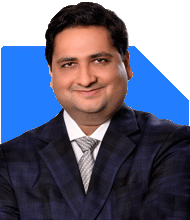Ramalingam Kalirajan |10881 Answers |Ask -Follow
Mutual Funds, Financial Planning Expert - Answered on May 10, 2024
He has an MBA in finance from the University of Madras and is a certified financial planner.
He is the director and chief financial planner at Holistic Investment, a Chennai-based firm that offers financial planning and wealth management advice.... more

I took VRS and my age is 51. I have invested my terminal benefit of nearly 90 lacs mostly in bank FD with monthly payout. I also get monthly pension of Rs. 60000 and rent of Rs 10000. My monthly expense is limited to 40000. My daughter is pursuing MSc and has 3 years to complete. I have recently started SIP for 10000 per month consulting a financial advisor. The funds are Mahindra manulife aggressive hybrid reg growth-3000, Samco flexicap reg G-2000, Whiteoak capital banking financial service reg G-3000, Whiteoak capital largecap reg G-2000. My goal is to make my corpus 2-3 crores in next 10 years.
With your terminal benefit invested mainly in bank FDs with monthly payout, along with a steady monthly pension and rental income, you have a reliable income stream to cover your expenses and support your daughter's education.
Starting SIPs in mutual funds is a smart move to grow your wealth over the long term. Your choice of funds reflects a diversified approach, covering different market segments and investment styles. It's essential to monitor the performance of these funds regularly and make adjustments as needed to stay on track towards your financial goals.
Your goal of reaching a corpus of 2-3 crores in the next 10 years is ambitious but achievable with disciplined saving and investing. Given your current investments and income sources, along with your SIP contributions, it's important to ensure that your investment strategy aligns with your risk tolerance and time horizon.
Consider consulting with a Certified Financial Planner to review your overall financial plan, assess your risk profile, and make any necessary adjustments to optimize your investment strategy. They can provide personalized guidance to help you achieve your financial goals while maintaining financial security and peace of mind.
Continue to stay focused on your goals, and with prudent financial management, you can build a substantial corpus for a comfortable and secure future.
Best Regards,
K. Ramalingam, MBA, CFP,
Chief Financial Planner,
www.holisticinvestment.in
You may like to see similar questions and answers below
Hardik Parikh | Answer |Ask -Follow
Tax, Mutual Fund Expert - Answered on Apr 11, 2023
Ramalingam Kalirajan |10881 Answers |Ask -Follow
Mutual Funds, Financial Planning Expert - Answered on May 04, 2024
Ramalingam Kalirajan |10881 Answers |Ask -Follow
Mutual Funds, Financial Planning Expert - Answered on Jul 15, 2024
Ramalingam Kalirajan |10881 Answers |Ask -Follow
Mutual Funds, Financial Planning Expert - Answered on Aug 13, 2024
Reetika Sharma |423 Answers |Ask -Follow
Financial Planner, MF and Insurance Expert - Answered on Oct 18, 2025
Dr Dipankar Dutta |1841 Answers |Ask -Follow
Tech Careers and Skill Development Expert - Answered on Dec 14, 2025
Nayagam P P |10854 Answers |Ask -Follow
Career Counsellor - Answered on Dec 14, 2025
Radheshyam Zanwar |6744 Answers |Ask -Follow
MHT-CET, IIT-JEE, NEET-UG Expert - Answered on Dec 14, 2025
Radheshyam Zanwar |6744 Answers |Ask -Follow
MHT-CET, IIT-JEE, NEET-UG Expert - Answered on Dec 14, 2025
Dr Dipankar Dutta |1841 Answers |Ask -Follow
Tech Careers and Skill Development Expert - Answered on Dec 14, 2025
Dr Dipankar Dutta |1841 Answers |Ask -Follow
Tech Careers and Skill Development Expert - Answered on Dec 13, 2025
Dr Dipankar Dutta |1841 Answers |Ask -Follow
Tech Careers and Skill Development Expert - Answered on Dec 13, 2025
Mayank Chandel |2575 Answers |Ask -Follow
IIT-JEE, NEET-UG, SAT, CLAT, CA, CS Exam Expert - Answered on Dec 13, 2025
Radheshyam Zanwar |6744 Answers |Ask -Follow
MHT-CET, IIT-JEE, NEET-UG Expert - Answered on Dec 13, 2025
Mayank Chandel |2575 Answers |Ask -Follow
IIT-JEE, NEET-UG, SAT, CLAT, CA, CS Exam Expert - Answered on Dec 13, 2025























